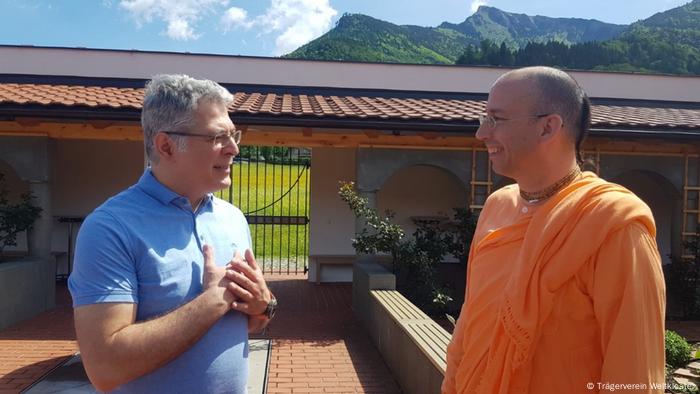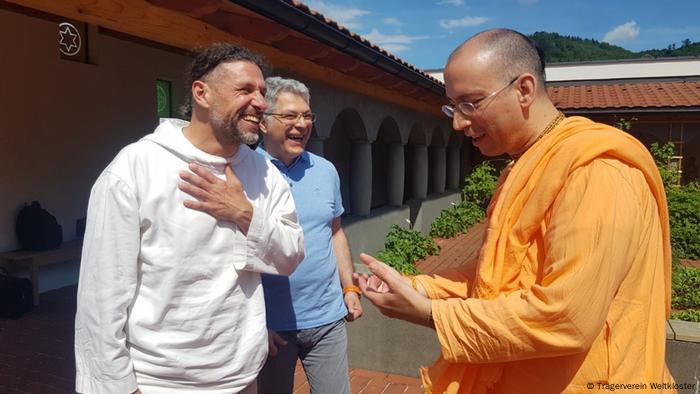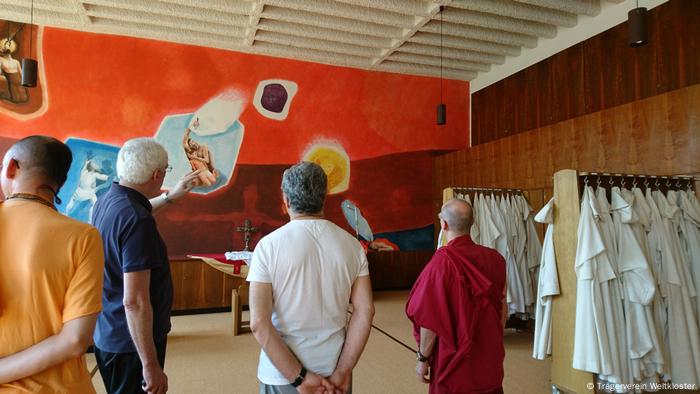Religions are often seen as the cause of conflicts and demarcation. Religious of different faiths want to change that with the “World Monastery” project. A small project with a big claim.
 < p>In conversation: The World Monastery project brings religious and clergymen of different religions together
< p>In conversation: The World Monastery project brings religious and clergymen of different religions together
“It is a time of exchange and learning,” says Thomas Hessler, referring to the Dalai Lama as the source of his statement. Hessler is a Benedictine monk. This week he was host to members of different religions in the Austrian monastery in Aich.
“We try to learn from and with one another. There are, for example, aspects of our Christian traditions that the Sufis have brought to my attention in a new way. “
Hüseyin Haybat sits next to Hessler during the conversation. The business informatics graduate works in software development – and he is a Sufi, a member of an Islamic movement that emphasizes mysticism.
Haybat describes a very old Sufi parable: “Religions are chalices, all containing the same nectar. He who tastes the nectar recognizes the nectar in every cup. Those who have never tasted argue about the shape of the vessel rather than the contents.”

Benedictine Thomas Hessler (left) and Sufi Hüseyin Haybat (2nd from left) in conversation with Hindu Krishna Premarupa Dasa
The Benedictine Hessler and the Sufi Haybat are actors in the “World Monastery” project. They came together with almost ten other believers this week in the Aich monastery, including a Muslim, a Hindu, a Buddhist and other Benedictines. A Christian nun of the Sisters of Mercy of the Holy Cross from the Hegne monastery in Allensbach on Lake Constance, a Munich rabbi and a Münster Baha'i were also connected online.
Signs against extremism
In In times of growing tension and division, they understand their exchange as a sign against extremism and war. “We want to give the world a sign that there is another way. We come from very different traditions and yet we trust and respect each other,” says Jakobus Geiger, Benedictine of Münsterschwarzach Abbey.
“Weltkloster” – the project was created in 2008 when various religious started on a common path. There was never a permanent joint monastery of the group. But for ten years the actors met in Radolfzell on the western edge of Lake Constance, where the “World Monastery” is still based today.

The religious representatives on a hike together near the Europakloster Gut Aich
Now Benedictine monasteries in southern Germany or in Austria serve as locations. As host Hessler says, it is always a reflection on the respective traditions of the pious actors. “You can compare it to a hike together. And while walking together, everyone perceives different things.”
The picture of the hike fits. Because common paths in front of the mountain panorama are part of the fixed program for the guests in the “Europakloster Aich” in Salzburger Land – like the times together in the meditation room of the monastery, and like the common silence and talking.
” Seeing the Common”
For Central Europeans who like to define denominational boundaries, the project may seem strange. For the religious it is consistent: “Those who only practice superficially only see the differences. But the more deeply I practice my own tradition, the more I am able to see what we have in common,” says, in fine Swiss German. The priest in the Krishna Temple in Zurich is a founding member of the Swiss umbrella organization for Hinduism.

The religious representatives met in 2019 in the Benedictine Abbey of Münsterschwarzach am Main
The religious representatives know about the common task. Her interreligious dialogue builds on lived spiritual experience, says Managing Director Alexandra Mann. That is why the spiritual encounters are successful. She hopes that those involved will bring the concerns of the project to the outside world more in the future, for example at academy conferences or when visiting schools.
Meet Frido Mann
At the end of the week in Aich, Frido Mann will also be there. The 81-year-old Swiss psychologist is the grandson of the writer Thomas Mann.
At a young age, Frido Mann converted to Catholicism. In 2009 he left the Catholic Church, citing the reconciliation gesture of the then Pope Benedict XVI as justification. versus Catholic traditionalists, including Holocaust deniers.
“I studied theology,” Mann told DW, but then he distanced himself from the church. In the “world monastery concept” it is “important that this is not a regulated dialogue, but a lived dialogue”.
“The group is characterized by the fact that we speak very openly to each other the downsides of one's own tradition are not taboo,” says Benediktiner Geiger. He can “very well” name the limits of his own tradition. “But you also realize that everyone only cooks with water,” and that each tradition has its own problems.
Are they changed, are they different people, when they break up after a week? Jakobus Geiger speaks of his “own inner transformation”. And further: “I wouldn't describe myself as a different person,” says the Benedictine, “but as a richer person.”